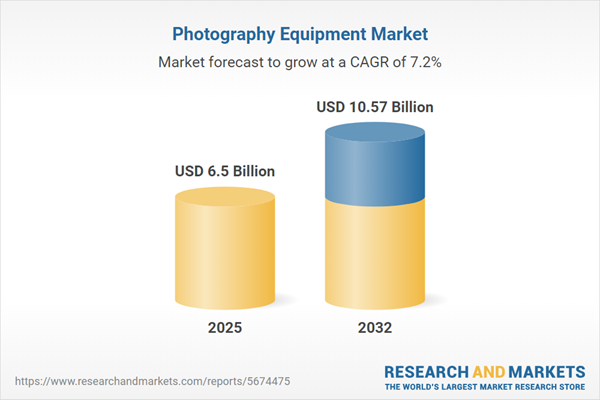Speak directly to the analyst to clarify any post sales queries you may have.
The photography equipment market is evolving rapidly as technology, user diversity, and global trade conditions reshape business priorities. Senior decision-makers must act decisively to harness this change, aligning strategy with demand dynamics, emerging technologies, and shifting market structures.
Market Snapshot: Photography Equipment Market
The global photography equipment market is currently valued at USD 6.07 billion, with expectations to reach USD 6.50 billion by 2025. An anticipated CAGR of 7.17% is projected to drive the market value to USD 10.57 billion by 2032. This sustained growth is attributed to significant advances in imaging solutions, tighter integration between digital and mobile technologies, and increased adoption by an increasingly broad user base. Organizations are recalibrating their strategies and business models to meet rising standards, capitalize on new applications, and respond efficiently to changing buyer preferences.
Scope & Segmentation for the Photography Equipment Market
This report provides actionable market intelligence to empower leadership teams and support agile planning across the photography equipment market. Each segment offers distinct strategic insight for responsive investment and operational strategy:
- Product Types: The analysis covers compact and premium cameras, superzoom models, APS-C and full-frame DSLRs, mirrorless cameras in various configurations, and micro four thirds solutions, helping enterprises refine offerings for both consumer and commercial clients.
- Distribution Channels: Assessment includes electronics retailers, mass merchandisers, camera specialists, direct-to-consumer outlets, authorized dealer portals, niche e-commerce, and major online marketplaces, supporting effective channel selection and market reach optimization.
- End Users: Segmentation spans casual hobbyists, dedicated enthusiasts, and professional users, guiding precise product positioning and development of tailored solutions for diverse user groups.
- Price Ranges: Coverage contains entry-level to premium segments, supporting balanced value propositions and improving placement within varied purchasing tiers.
- Regions: Detailed insights address the Americas, Europe, Middle East & Africa, and Asia-Pacific, along with key national markets, to inform targeted resource deployment and investment prioritization.
- Companies: Profiles feature Canon Inc., Sony Group Corporation, Nikon Corporation, Fujifilm Holdings Corporation, Panasonic Corporation, OM Digital Solutions Corporation, Ricoh Company, Ltd., Leica Camera AG, Hasselblad AB, and Sigma Corporation, illustrating strategic shifts and evolving directions within the competitive landscape.
Key Takeaways for Senior Decision-Makers
- Artificial intelligence and sensor innovation are enhancing accessibility to advanced photography, enabling greater automation and creative workflows across varied user skill levels.
- Integrated omnichannel approaches blend digital and in-person customer experiences, fostering stronger brand engagement and increasing market resilience against competitors.
- Environmentally conscious design and modular product formats are gaining customer traction, improving sustainability positioning and supporting loyalty objectives.
- Flexible manufacturing processes and robust supply partnerships are central to mitigating supply chain risks and ensuring operational flexibility during ongoing industry changes.
- Targeted segmentation based on user purpose and budget tier drives precision in product innovation and marketing, especially in areas like mirrorless and compact cameras.
- Localized frameworks and tailored regional support allow quick adaptation to emerging trends, sustaining customer satisfaction and responsive resource allocation.
Tariff Impact: Strategic Considerations
New camera import tariffs in the United States are prompting manufacturers to move production to Southeast Asia and Latin America. This relocation is adjusting the cost base and altering competitive positioning throughout the photography equipment market. Companies are responding with bundled offerings, revised pricing strategies, and enhanced service models to safeguard market presence amid changing trade landscapes.
Methodology & Data Sources
Market research leverages structured interviews with executives from manufacturing, distribution, and retail, complemented by end-user surveys, proprietary industry analyses, regulatory reviews, pricing benchmarks, and supply chain expert guidance to secure data reliability.
Why This Report Matters
- Helps senior executives recognize and address technology shifts and regulatory developments, promoting greater business agility.
- Supports informed procurement and resource risk management with detailed supply chain insights.
- Equips leadership with practical analysis to optimize capital allocation and advance adaptive business strategies in a complex market environment.
Conclusion
Anticipating innovation and responding swiftly to change is essential for leaders in the photography equipment sector. This report enables executives to steer their organizations through evolving market challenges and capitalize on emerging opportunities.
Additional Product Information:
- Purchase of this report includes 1 year online access with quarterly updates.
- This report can be updated on request. Please contact our Customer Experience team using the Ask a Question widget on our website.
Table of Contents
3. Executive Summary
4. Market Overview
7. Cumulative Impact of Artificial Intelligence 2025
List of Figures
Samples

LOADING...
Companies Mentioned
The key companies profiled in this Photography Equipment market report include:- Canon Inc.
- Sony Group Corporation
- Nikon Corporation
- Fujifilm Holdings Corporation
- Panasonic Corporation
- OM Digital Solutions Corporation
- Ricoh Company, Ltd.
- Leica Camera AG
- Hasselblad AB
- Sigma Corporation
Table Information
| Report Attribute | Details |
|---|---|
| No. of Pages | 197 |
| Published | October 2025 |
| Forecast Period | 2025 - 2032 |
| Estimated Market Value ( USD | $ 6.5 Billion |
| Forecasted Market Value ( USD | $ 10.57 Billion |
| Compound Annual Growth Rate | 7.1% |
| Regions Covered | Global |
| No. of Companies Mentioned | 11 |









